Let’s talk about eggs… not your everyday, run-of-the-mill eggs, but different types of oval marvels that have cracked open the culinary world of taste and nutrition. Gone are the days when a simple chicken egg was your only choice. In this era, the egg scene has undergone a thrilling transformation that’s nothing short of egg-citing.
From the dainty size of quail eggs to the bold and rich flavor notes of duck eggs, these food options will set to modernize your menu and dining experience. Whether you prefer frying, poaching, scrambling, or baking, the wide varieties of eggs can do it all.
1. Chicken Eggs
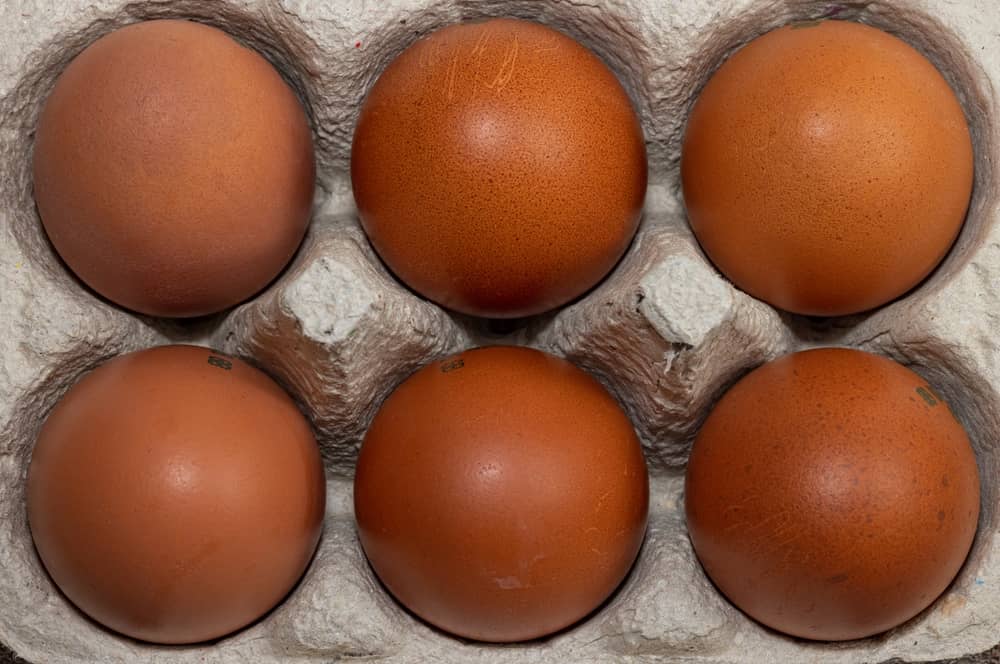
Whether scrambled, fried, or boiled, chicken eggs are delicious.
©Carl DeAbreu Photography/Shutterstock.com
Chicken eggs are widely popular across the globe due to their versatility, affordability, and nutritional value. Different farming methods produce these eggs, which include chickens raised in cages while others are raised to roam free and eat off the land. Farmers collect developed eggs after 21 days and make them available for purchase in supermarkets.
The color of chicken eggs varies depending on the breed resulting in a choice between white or brown eggs. Nutritionally eggs offer a source of high-quality protein and, essential vitamins like B12, selenium, and healthy fats like omega 3. In addition, health specialists recommend consuming around 3 to 7 eggs per week.
Taste Profiles and Best Uses for Chicken Eggs
Their taste is often described as mild, which makes them a great base to soak up the flavors of ingredients added to your dish. Chicken eggs have long been known for their role in baking. They provide binding properties that are essential in recipes that create cakes and bread. Furthermore, as for savory dishes, one can whip up some scrambled eggs as a simple breakfast staple or a delicious quiche for dinner.
2. Quail Eggs
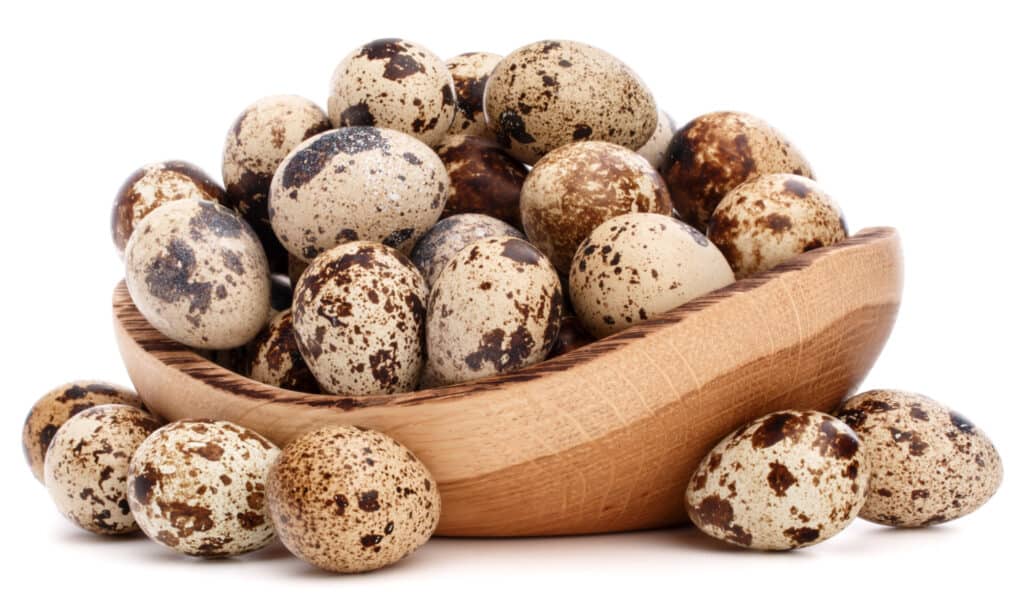
Mediterranean cuisines consider quail eggs a delicacy.
©Nattika/Shutterstock.com
Quail eggs are small eggs laid by quail, a small bird species. These speckled eggs display scattered black, brown, and cream spots that measure approximately one inch long. These beautiful eggs are considered a delicacy among Mediterranean cuisines, especially when creating high-end dishes.
Although quail eggs may appear small, don’t let their size deceive you, as they provide a rounded combination of protein and minerals. Did you know that quail eggs have a large proportion of yolk to white compared to chicken eggs? This feature makes them a top choice among chefs as they add a unique flavor when incorporated into their culinary dishes.
Taste Profiles and Best Uses for Quail Eggs
The taste of a quail egg is often characterized as having a slightly earthy flavor. Since these eggs are predominantly composed of yolk, their creamy texture adds great depth when added to ingredients. Furthermore, if you want to enjoy a quail egg to the fullest, it’s recommended to have it poached. This cooking method truly enhances the richness of the yolk when added to salads and sushi.
3. Duck Eggs
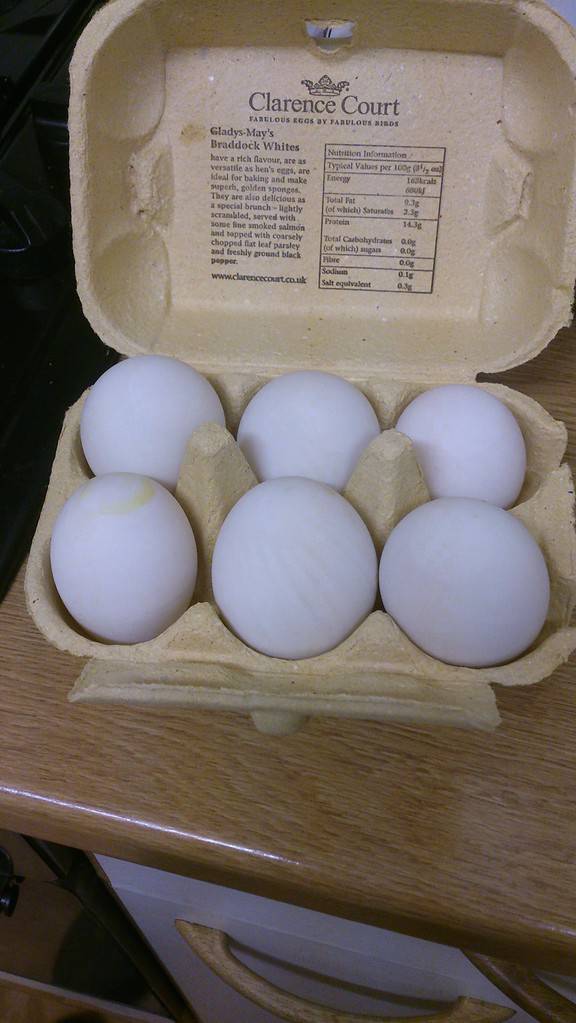
One of the more popular types of eggs is duck eggs.
©Evenflow357 / CC BY-SA 3.0 – License
For many generations, duck eggs have always been enjoyed among Asian and European cultures. The reasoning behind its popularity is that they are 50 percent larger than chicken eggs and holds a higher fat content. Moreover, there’s a range of colors to choose from, including white, green, and blue. You might even stumble across a rare duck egg that’s covered in spots!
For individuals who have allergies to chicken eggs, duck eggs may be an alternative due to variations in protein composition. However, individuals struggling with high cholesterol should consume fewer duck eggs and stick to the classic chicken egg.
Taste Profiles and Best Uses for Duck Eggs
Duck eggs offer a rich, buttery flavor, especially when added to custard and pastries. Thanx to its velvety texture; your omelets, quiches, and scrambled eggs will melt in your mouth.
4. Goose Eggs

Hardy and thick, goose eggs have a higher vitamin concentration in their yolks.
©Picture Partners/Shutterstock.com
Goose eggs are oval-shaped and approximately three times larger than the average chicken egg. The egg yolks’ increased vitamin concentration makes them a more nutrient-rich choice. These hardy eggs feature a thicker shell that ranges in color from pale white to shades of cream and even light blue.
Goose eggs are not only valued for their taste but sought after for crafting endeavors. Eggshell carving and adding a splash of color through dyeing techniques can turn your goose egg into a work of art.
Taste Profiles and Best Uses for Goose Eggs
Goose eggs possess a bolder profile with a subtle hint of gaminess in their taste. The yolk’s increased size adds a slightly thicker consistency, which is perfect for an indulgent carbonara sauce.
5. Turkey Eggs

It can be difficult to find turkey eggs in a supermarket.
©Elias Glesmann/Shutterstock.com
Weighing around 2.5 to 3.5 ounces, turkey eggs surpass both duck and goose eggs. Turkeys produce fewer eggs than chickens, so you may not find them as readily available in supermarkets. If you can get your hands on some turkey eggs, their rich source of vitamin B12 aids in preserving nerve health and generating healthy red blood cells.
Furthermore, for egg enthusiasts, turkey eggs hold the potential to become prized collector’s items, introducing an element of uniqueness and exclusivity to their charm.
Taste Profiles and Best Uses for Turkey Eggs
With their robust flavor that harmonizes with spicier components, turkey eggs are an excellent selection for boldly flavored dishes. Also, its creamy texture makes for a tasty homemade mayonnaise.
6. Ostrich Eggs

It takes around 40 to 45 days to produce an ostrich egg.
©iStock.com/Nicki1982
Among all types of birds, ostrich eggs take the throne for being the largest egg of all. On average, they weigh around 3 pounds. To give you an idea, it takes 24 chicken eggs to match the size of a single ostrich egg. These large eggs have a cream-colored shell with speckles that serve as a safeguard for the growing embryo. It typically takes around 40 to 45 days to produce an egg from the moment of mating.
In addition to this, ostrich eggs sometimes have two yolks, which makes them quite unusual when it comes to cooking. Also, in African cultures, locals create jewelry using fragments of ostrich eggshells to create beads and pendants.
Taste Profiles and Best Uses for Ostrich Eggs
Ostrich eggs provide one’s palate with a mild eggy flavor compared to chicken eggs. Just think, when pressed for time and don’t know what to make for dinner, you can whip up a healthy meal and make an impressive-sized omelet.
7. Crocodile Eggs

The cost of
crocodile
eggs is very expensive.
©Catchlight Lens/Shutterstock.com
Crocodile eggs have gained popularity among exotic food markets and fine dining restaurants in Africa, Asia, and Australia. Because crocodile farming requires a lot of skill and knowledge, the cost of crocodile eggs tends to be quite high.
When trying new foods, especially crocodile eggs, exercise caution regarding any health hazards. Ensure thorough cooking practices to prevent any likelihood of encountering foodborne illnesses.
Taste Profiles and Best Uses for Crocodile Eggs
Believe it or not, crocodile eggs have a similar taste to chicken eggs. As for cooking techniques, you can boil, fry and even scramble them. In fact, some cooking enthusiasts even like to explore the possibilities of using crocodile eggs in baking.
8. Caviar
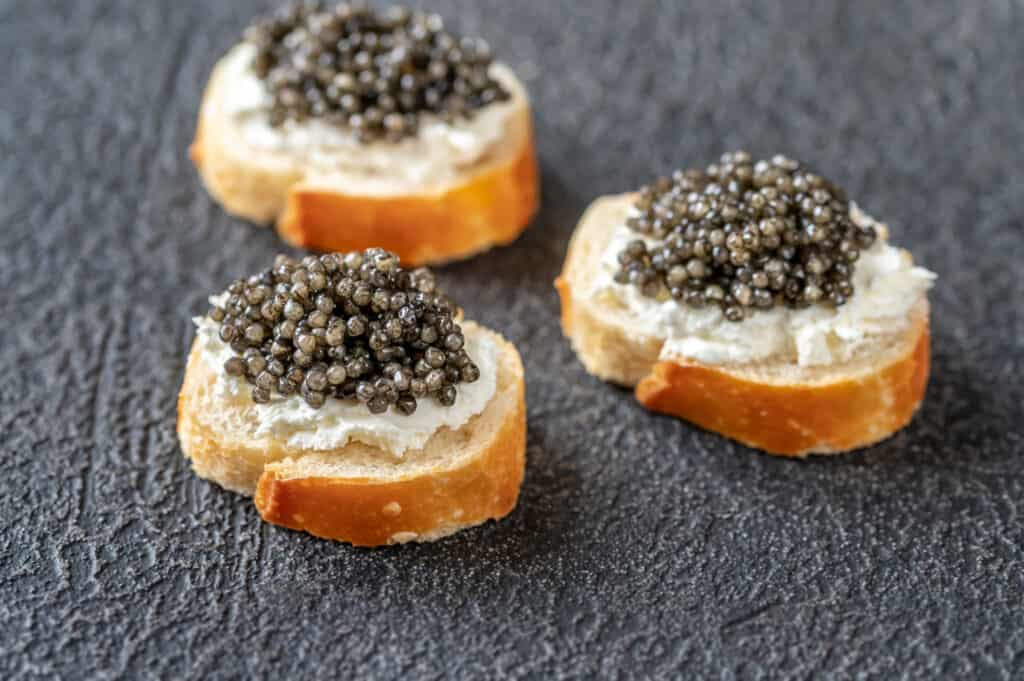
Another type of delicious egg, Caviar, pairs well with crème fraîche.
©Alexander Prokopenko/Shutterstock.com
Caviar eggs are branded for the rich and famous. The delicacy of its eggs is created by preserving and salting different types of sturgeon fish eggs. Beluga, Osetra, and Sevruga are well-known varieties of caviar. Taste, size, and color characteristic determines the value of each batch of caviar.
The availability of prime-quality caviar is restricted because of the decreasing number of sturgeons and overfishing. Consequently, it has become rare, exclusive, and has a hefty price tag.
Taste Profiles and Best Uses for Caviar Eggs
Chefs serve caviar raw in small portions, often served on blini or bite-sized toast. To add to its presentation, caviar pairs well with crème fraîche, chopped onions, and eggs. In addition, these tiny eggs release a nutty, briny, and sometimes even slightly metallic flavor.
9. Pigeon Eggs
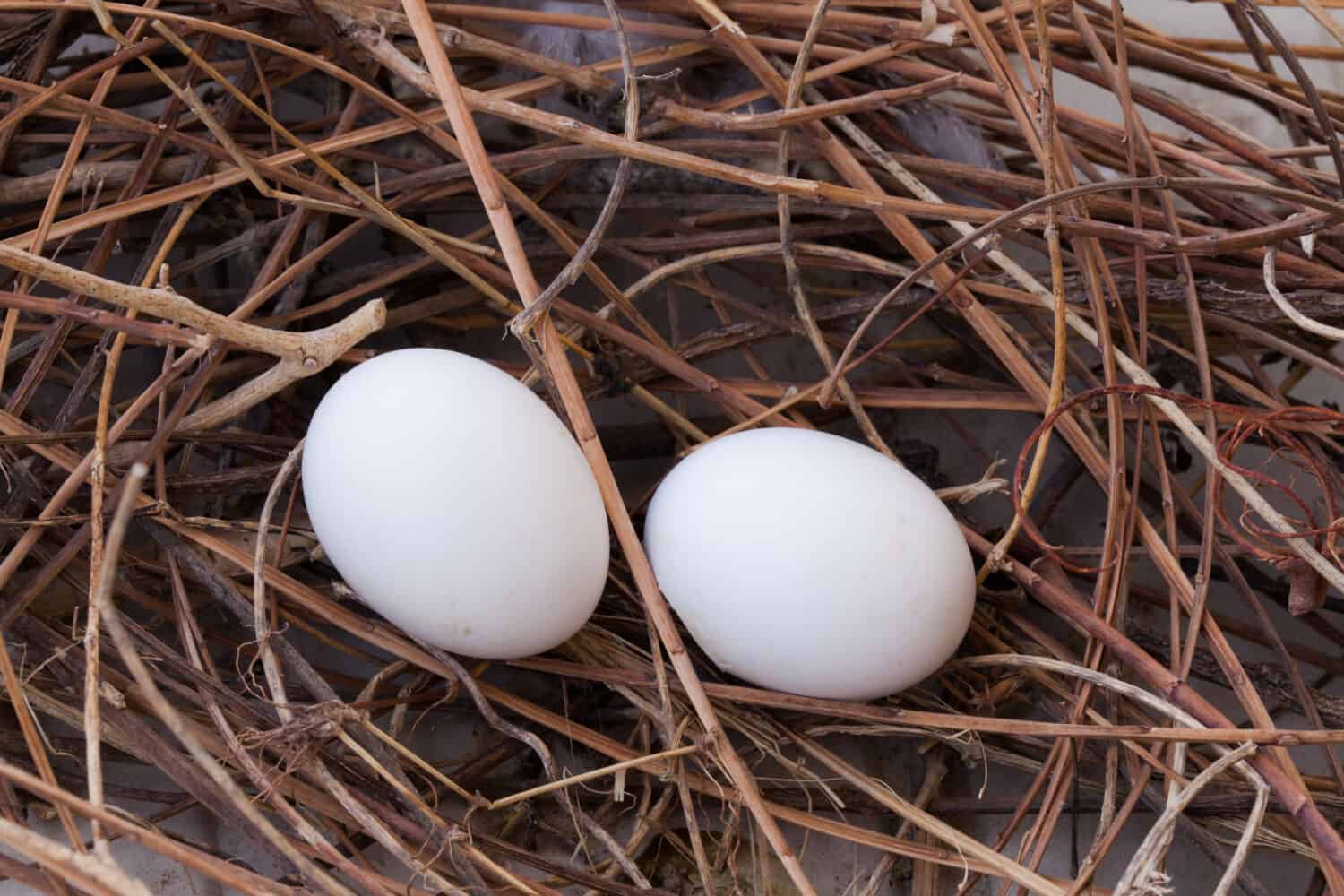
Chinese medicine believes in the healing power of pigeon eggs for fertility and other medical concerns.
©Irit/Shutterstock.com
Pigeon eggs are filled with rich nutrients that include vitamin D, vitamin B12, iron, and phosphorus. These bird eggs measure about 1 to 1.4 inches in length and display a smooth glossy surface. These birds have an interesting way of laying their eggs. Each pair of eggs laid gets separated by a day.
Furthermore,in Chinese medicine, pigeon eggs have long been believed to have positive effects on fertility and low libido.
Taste Profiles and Best Uses for Pigeon Eggs
Pigeon eggs are perfect for creating gourmet dishes or appetizers. You can boil, fry or use them as garnishes to enhance your meals’ richness and umami taste.
10. Emu Eggs
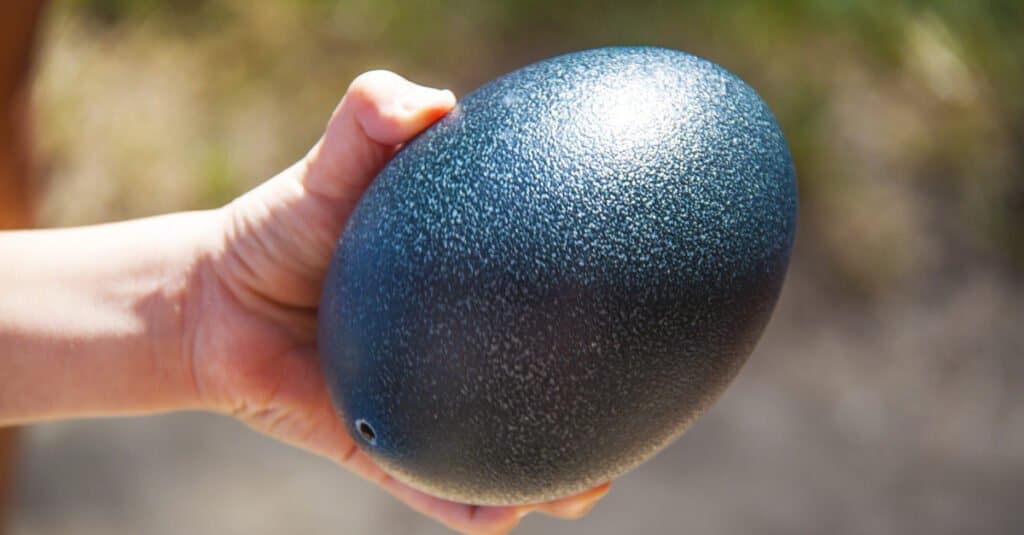
With an appearance like a Haas avocado, emu eggs are quite a sight in the wild.
©Alisa Burkovska/Shutterstock.com
Emu eggs belong to the largest bird species in Australia. These eggs are highly sought after because of their greenish-black color. What’s even more eye-catching is its rough eggshell. You just might mistake its appearance for a large Hass avocado.
Because Emus are a protected bird species, their eggs cannot be collected from the wild. However, licensed emu farms may be allowed to gather eggs for consumption purposes.
Taste Profiles and Best Uses for Emu Eggs
These eggs have a wide variety of egg-based recipes such as frittatas, shakshuka, and egg casseroles. In particular, Emu egg’s versatility and creamy taste offers egg-cellent depth to these egg dishes.
The photo featured at the top of this post is © Fburnette/Shutterstock.com
Thank you for reading! Have some feedback for us? Contact the AZ Animals editorial team.






